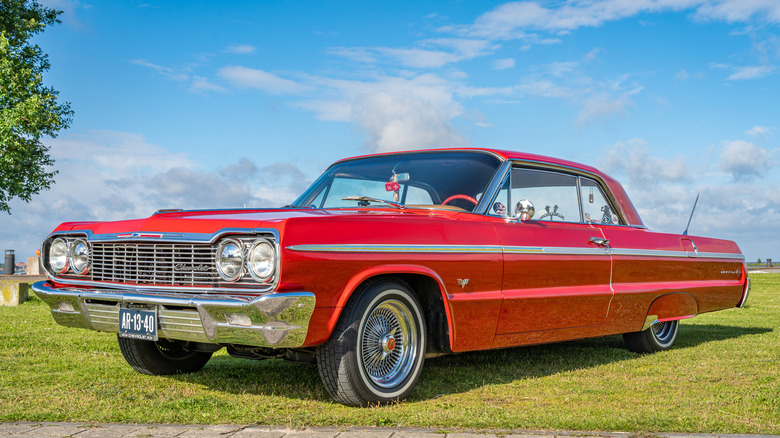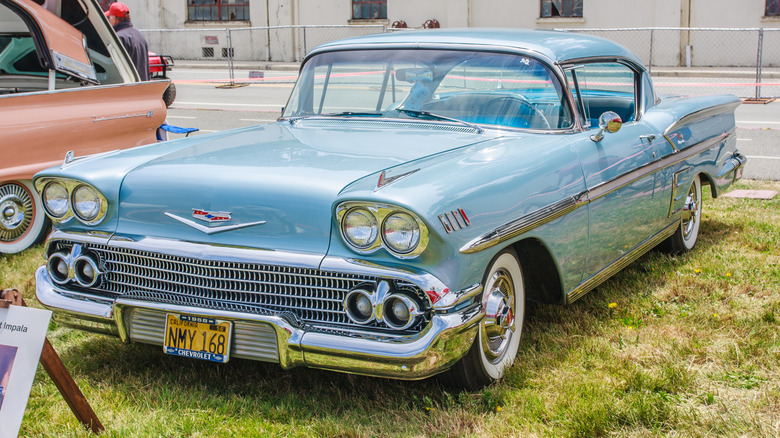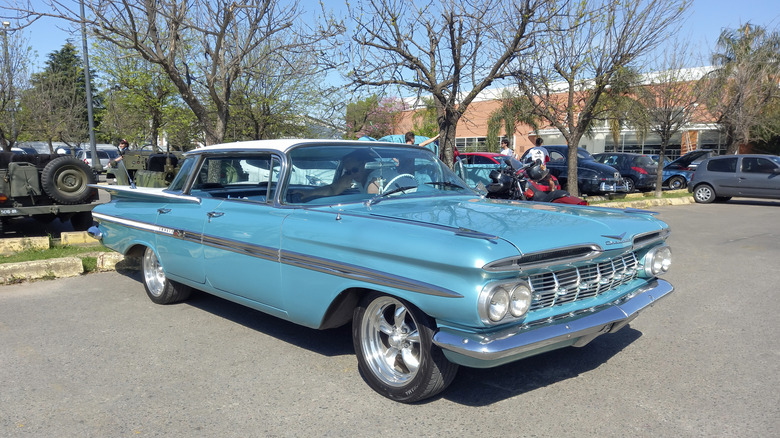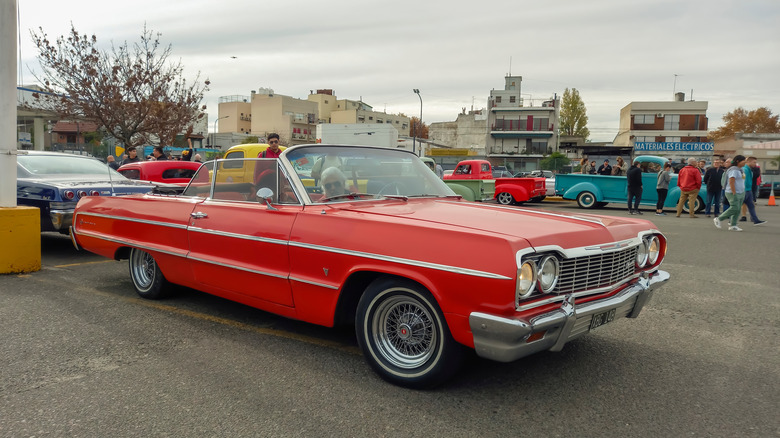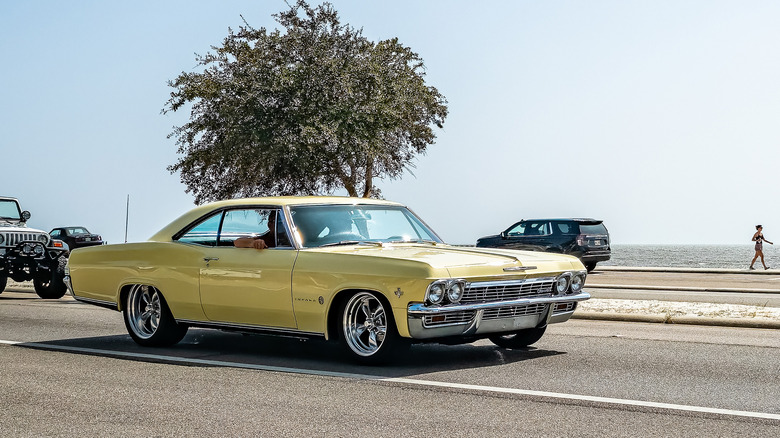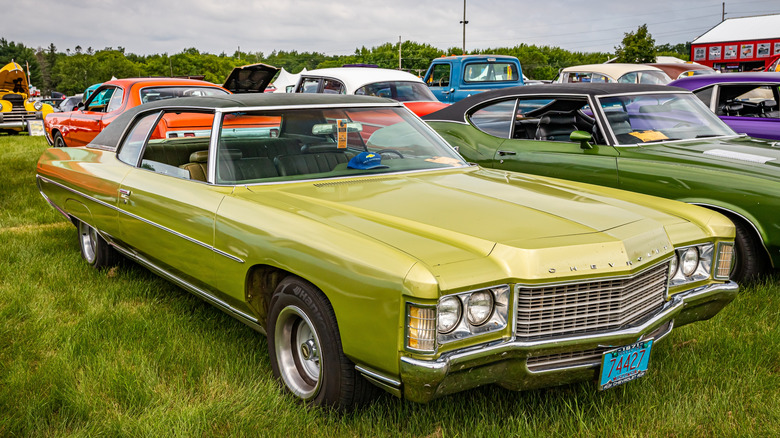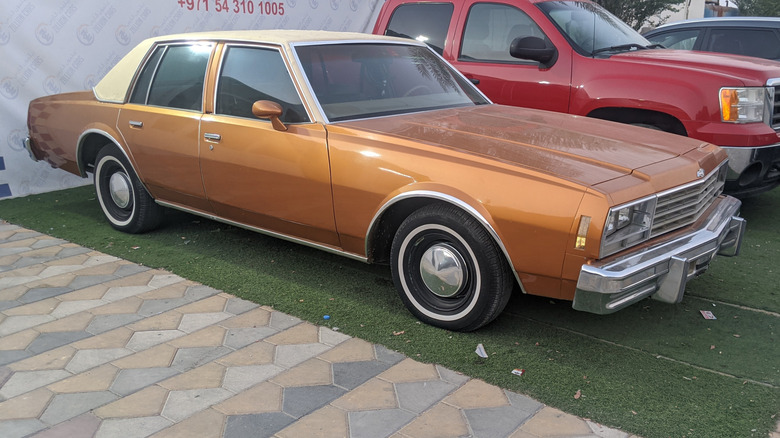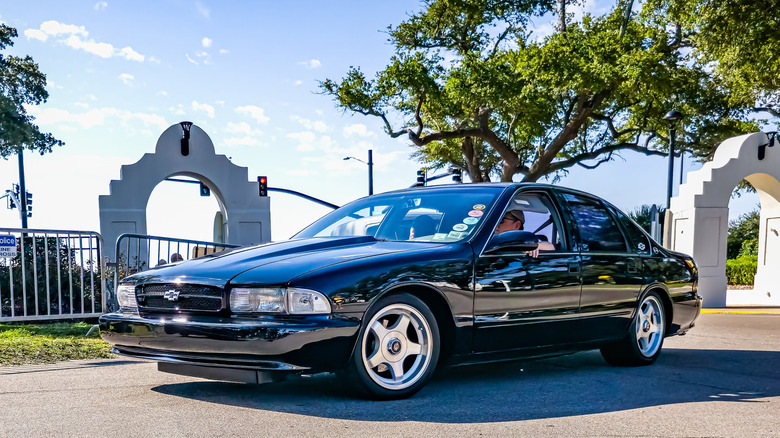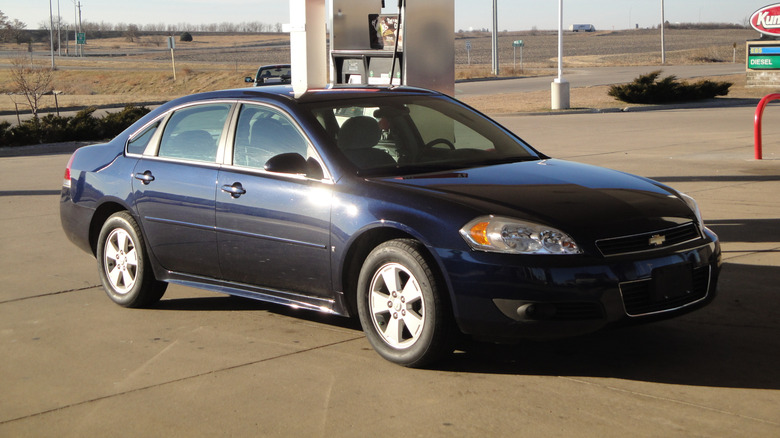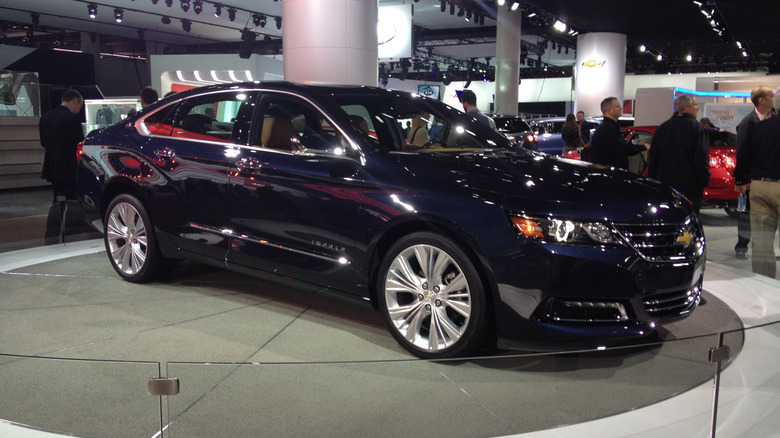Chevy Impala: The Rise And Fall Of A Generational Automotive Icon
The American automotive industry really came into its own in the 1950s, as this was the era when some of the greatest American cars of all time first appeared. The Chevy Bel Air (which might return in 2025), the rise in popularity of the Ford F-Series, and so on. The 1950s also gave birth to a totally new auto type that would take the United States by storm: the personal luxury car.
It was a pretty simple idea. A long, usually two-door coupe with the best possible features the automaker could offer at the time. This all started in the late 1950s with a new trim level for the Chevrolet Bel Air, the Impala. Eventually, this spun off into its own separate model simply called the Impala, and the rest is history. Let's dive into the rise and fall of one of the greatest American car icons of all time.
A trim level for the Bel Air
Fun fact: A lot of the current American car nameplates started as trim levels for different vehicles way back when. A great example being the Ford F-100 Ranger, but also the Chevrolet Bel Air Impala. The Bel Air was Chevy's flagship full-size car back then, and the Impala trim was the flagship of the flagship.
No expenses were spared on the Impala Bel Air, and it became a runaway success. Despite the fact that a recession had started in 1958 when it was introduced, Chevy still managed to shift a more than respectable number of units, which ultimately led to the spinoff. A variety of powertrains were on offer for the Bel Air Impala, with a three-barrel carbureted 5.7-liter (347-cubic-inch) V8 putting out a more than adequate 280 horsepower. Almost no one remembers this Impala, but what happened next sent Chevrolet and GM into total stardom.
The beginning of the personal luxury car
While the all-new-for-1959 Impala couldn't claim the title of the first ever personal luxury vehicle, it was still among the first few, and it took the whole segment into high gear right alongside the original and very successful Ford Thunderbird. Launched for model year 1959, the Impala became the overall flagship in the Chevrolet lineup.
There were multiple body styles on offer, including the highly celebrated Impala Sport Coupe, along with a four-door sedan and a station wagon. Even with those other versions, most people associate the Impala with the Sport Coupe body style. The 1959 Impala also has some of the most distinctive styling traits in American car history, including the mustache, if you will, above the front grille and the tilted fins around the back.
General Motors (GM) wasn't totally immune from the recession, which led to some minor cost-cutting measures. That didn't deter Impala customers, however, and the car continued to be successful well into the recession and well into the next decade. Then, things got even more special.
Less fins, more Power
The 1959 Impala is very distinctive thanks to the sharp fins on the rear end, which kind of look like slightly flattened Cadillac fins. In 1961, a new generation was in order, and sadly, the fins were completely removed. The new body shell also moved the grille and headlights much lower down, giving the front end a totally new look.
Overall, this generation of the Impala was much boxier than before, but that wasn't a bad thing at all. It was still quite the sight to behold — in a good way. More important than any of this, though, was the addition of a new top-of-the-line model in the Impala range, and one that this car would become famous for: SS.
Before there was ever a Camaro SS, there was the Impala SS. This is one of the best-known versions of the Impala SS, and there was a lot to love about it. You could have it with your choice of six-cylinder and V8 power, sure, but the crème of the Impala SS crop is the 6.7-liter big (409-cubic-inch) big-block V8 with up to 425 horsepower. Yes, people, 425 horsepower in a Chevy from the '60s. That was truly massive power back then, and it's still pretty punchy today. That being said, if you can settle with one of the less powerful engines, the Impala SS is actually a relatively affordable way to get into classic American car ownership (and it's still a highly sough-after collector's car).
A household name
1965 saw the release of a new generation of Impala, and it was pretty radically different from its predecessor. Gone was the 1950s Americana and the more boxy design of the early '60s, and in their place came something that was much closer to the famous Coke bottle design popularized by the likes of the Dodge Charger.
The Impala continued the coupe and the sedan versions, and fans of "The Crew" video game will immediately recognize the sedan from this generation. Underneath, GM had retired the X frame that the Impala used for the longest time. Overall, three very important things happened during the third-gen Impala's tenure.
For one, the Impala crossed 1 million units produced in 1965, solidifying it as a household name in the North American market. Secondly, the SS let out its last gasp for model year 1969, after which the name went into retirement. Finally, Chevy introduced a luxury trim level called the Caprice, which was then spun-off as a separate flagship Chevrolet model, knocking the Impala off the top spot. The Impala continued to be a great car throughout the '60s — and then, the 1973 oil crisis happened.
The beginning of the oil crisis
1971 saw the introduction of the fifth-generation Chevy Impala, which ended up being Chevrolet's largest car on offer at the time. This was a period when station wagons could seat more than five people — up to nine in the case of the Impala, which was very impressive. But even though this generation of the Impala started off strong, with great styling and some awesome powertrains to choose from, it soon became obvious that the end of an era was approaching. This was the last Impala generation to be offered as a convertible, and it was eventually burdened by federal regulations that the U.S. government began rolling out in the early 1970s.
This included new regulation-friendly bumpers, which upset the styling a fair bit. Not only that, but the lower-compression engines designed to handle unleaded gasoline and catalytic converters meant a pretty catastrophic loss of power. The Impala had fallen off a fair bit by the mid-'70s, and things were about to get even worse.
The Impala name is discountinued
In 1977, Chevrolet launched the sixth-generation Impala. It arrived precisely on time for the Malaise era and the whole American car industry downsizing its cars. Unsurprisingly, this Impala was way smaller than its predecessor, and it was also based on the B-body platform shared with other GM sedans.
The convertible model was done for, and by this point, the oil crisis damage had been done to the massive engines used by basically every American car. The Impala's powertrains simply weren't up to the task of moving around this still relatively massive car, and GM's cost-cutting and poor engineering during this time certainly didn't help matters. By the beginning of the 1980s, Chevy Impala sales had dwindled to almost nothing, and interest in the Impala had all but disappeared.
Chevrolet simply couldn't justify having the Impala in the lineup any longer, which led to the car's discontinuation in 1985. The sixth-generation Impala took the nameplate as a whole down with it, and the Chevy Caprice was tasked with plugging the hole that it left behind. Except, Chevy wasn't entirely done with the Impala just yet.
A brief comeback
In 1994, Chevrolet decided to have some fun and put together a performance version of the full-size Caprice sedan. By this point, the Caprice had become the darling of fleet sales, commonly being used as a taxicab, rental car, and police car. The performance model was special, so it needed a special name: Impala SS.
That's right — despite there no longer being an Impala in Chevrolet's lineup, from 1994 to 1996, you could buy the Impala SS, based on the Caprice from that time. Under the hood was a 5.7-liter LT1 V8 putting out 260 horsepower and 330 pound-feet of torque, which was sent to the rear wheels through a four-speed automatic transmission. Along with various drivetrain upgrades, the Impala SS also received some pretty menacing styling including ground effects, those famous five-spoke wheels, and the special Impala badging all over the bodywork. A decently kept B-body Caprice can be bought off Craigslist for next to nothing, but the '94-'96 Impala SS is already on the way to becoming a classic car. It's easily one of the coolest Chevys of the '90s.
A front-driven revival
Shortly after the Impala SS went away post-1996, the B-body sedan platform was retired altogether. The Caprice, the Roadmaster, the Fleetwood, all that jazz. Ultimately, GM decided that a full-size sedan should remain a fixture of the Chevrolet lineup, leading to the reintroduction of the Impala nameplate for model year 2000.
Right off the bat, there were some problems. For one thing, in terms of design, the Impala lost one of the biggest draws of the original brand. The road presence, the authority, the effortlessly cool overall shape — it was all binned in favor of a pretty boring three-box sedan shape and circular taillights that people humorously compare to the Nissan R34 Skyline.
Unlike every other Impala that came before it, the eighth-generation was front-wheel drive, and it didn't even offer a V8 engine at all. This began the Impala's infamous transition from king of the Chevrolet lineup to king of the rental car lineup. And this shift only continued throughout the decade and well into the next one.
One more Impala SS
Clearly, Chevrolet had heard people's complaints loud and clear. In 2006, it released of an all-new Impala, once again taking the place of the full-size sedan in Chevrolet's model lineup. It was still front-wheel drive, and although it had all-new styling, it still wasn't much to write home about.
The eighth generation of Impala was simply not good enough, whereas the ninth-gen was just bulbous and massive for no reason. It also didn't have much in the way of style, as Chevy didn't really bother to give it any meaningful touches on the outside. It blends in with basically every other car, perhaps too much.
Despite being front-wheel drive, General Motors somehow saw fit to give this car a V8 engine to create a new Impala SS. Like you'd expect, it's one of many GM products to use the small-block LS engine. With 303 horsepower and 323 pound-feet of torque, the Impala SS could reach 60 mph in around five seconds, which was pretty good. However, putting a heavy V8 engine in a front-wheel drive sedan went about as well as you'd expect, and the car's rental darling status continued to haunt it. This time, it really was the last hurrah of the Impala SS nameplate.
Fleet sales darling
In 2014, General Motors decided to give the Impala one last shot with an all-new full-size sedan. Competing with the likes of the Ford Taurus and Toyota Avalon, the 10th-generation Impala was a huge improvement over its predecessor, at least in the style department. It was still front-wheel drive, but it was placed on the much more modern Epsilon II platform. For comparison, the ninth-generation Impala's platform was already two decades old by the time it had come out. The silly V8 option was also gone in favor of a four-cylinder or a V6, along with a hybrid four-cylinder in the Impala eAssist.
Despite Chevy's best attempts to claw back some sales in the full-size sedan market, it simply wasn't enough. The Impala continued to be a darling for fleet buyers, and frankly, that's true of every Impala for the 21st century. Even when the 10th generation of cars came out, the ninth-gen continued production exclusively for fleet buyers. Then, the sedan market as a whole started to shrink massively, and Chevrolet ended the Impala name in 2020 — for real this time. With that, the American car dynasty that put General Motors on the map back in the '50s was retired, and that makes us sad.
